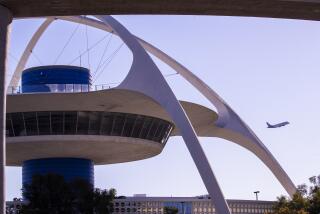FedEx Jet Narrowly Averts Crash With Private Plane
- Share via
WASHINGTON — A FedEx cargo jet taking off from Los Angeles International Airport narrowly avoided colliding with a small private plane this week, the Federal Aviation Administration confirmed Thursday.
FAA spokesmen said the FedEx Airbus A310, with a crew of two, overflew a Piper Comanche by 200 feet at 6:36 p.m. Tuesday, just before sunset.
Controllers at the airport said the close call was the result of a flawed air traffic procedure that they believe should not be used at the airport. The FAA, however, initially has blamed a controller’s error for the incident, although the agency is still investigating.
The FedEx jet, bound for Phoenix, was taking off to the west over the ocean. The small plane was northbound toward Santa Monica on a route that skirts the shoreline just west of the airport and is often used by private aircraft.
Both planes had been cleared to an altitude of 3,000 feet, inadvertently placing them on a collision course.
Los Angeles International is the world’s fourth-busiest airport in the number of passengers served but it is one of the country’s smallest in terms of the physical area it occupies. That combination increases the pressure on controllers, as they strive to keep a constant stream of aircraft safely separated from one another.
Mike Foote, head of the National Air Traffic Controllers Assn. at the Los Angeles facility, said the route used by the private plane is a hazard that predictably causes one or two near misses in any given two-year period.
“It’s a very, very dumb procedure and it’s hard to believe that at the world’s fourth-busiest airport we are launching aircraft directly into crossing traffic,” Foote said. “This was a cargo flight but it could just as easily have been a Boeing 747 with 400 people on it.”
FAA spokesman Jerry Snyder said the agency is aware of the controllers’ concerns. “There has been discussion about putting a committee together to look at that sometime in the near future,” he said. “It is something the FAA is concerned with.”
Snyder, however, disputed Foote’s assertion that allowing small planes to cross the shoreline near the airport is inherently unsafe. “It is working,” he said.
Snyder said the controller involved in the incident will have to undergo retraining before he can return to his usual duties.
In the cramped confines of the tower, a system of alarms and lights is supposed to warn controllers when a small aircraft is about to cross the shoreline, Foote said. Controllers then instruct departing jets to maintain a lower altitude as they climb away from the immediate vicinity of the airport.
Foote suggested that the warning system may have malfunctioned Tuesday, but Snyder said there is no evidence of that.
Foote said the FedEx pilot took evasive action and climbed to avoid the Piper Comanche, although neither the FAA nor FedEx could confirm that.
“The FedEx crew performed safely and appropriately,” said company spokeswoman Darlene Faquin.
Private planes and jets have collided in Southern California’s busy airspace in the past.
The worst air disaster in the state’s history was the 1978 collision of a Pacific Southwest Boeing 727 and a Cessna 172 over San Diego, which killed 144 people.
More to Read
Inside the business of entertainment
The Wide Shot brings you news, analysis and insights on everything from streaming wars to production — and what it all means for the future.
You may occasionally receive promotional content from the Los Angeles Times.










